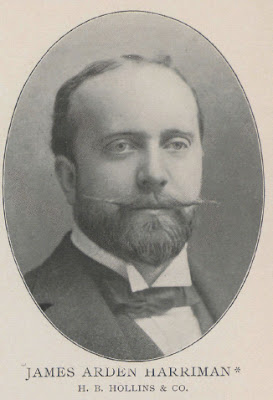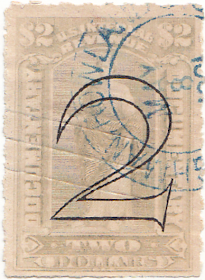Examples of printed cancels used by the St. Louis Southwestern Railway. Because of Texas corporate law, the Texas branch of the St. Louis Southwestern was incorporated with its own name and a symbolic headquarters in Texas. The railroad was known as "The Cotton Belt Route".
Samuel Wesley Fordyce was a businessman who spearheaded efforts to build thousands of miles of railway in the South and Southwest during the late nineteenth century, including the Cotton Belt route that crossed Arkansas. He also was a major force behind the transformation of Hot Springs (Garland County) from a small village to major health resort. The town of Fordyce (Dallas County) is named for him, as is the Fordyce Bath House in Hot Springs.
Samuel Fordyce was born on February 7, 1840, in Senecaville, Ohio, the son of John Fordyce and Mary Ann Houseman Fordyce. As a boy, he never liked school, but he attended Madison College in Uniontown, Pennsylvania, and North Illinois University in Henry, Illinois, before becoming a station agent on the Central Ohio Railroad at the age of twenty. Soon thereafter, he enlisted as a private in the First Ohio Volunteer Cavalry to fight in the Civil War. He quickly rose to officer status and participated in the Battles of Chickamauga and Shiloh, among others. During his time of military service, he suffered multiple broken bones and contracted malaria.
After the Civil War, Fordyce moved to Huntsville, Alabama. He married Susan E. Chadick on May 1, 1866. The couple had five children. During Fordyce’s decade in Huntsville, he partnered with William Richard Rison, a former bookkeeper and cashier, to establish the company of Fordyce and Rison. The banking firm played a leading role in the development of northern Alabama by financing businesses and other economic ventures.
War injuries affected Fordyce’s health, so he visited Hot Springs in 1873 to obtain the benefits of the spa’s healing waters. He returned with his family to live in 1876. Fordyce recognized the possibilities of Hot Springs as a health resort and worked to turn those possibilities into reality. He invested in the town’s leading hotels, including the Arlington and Eastman; the opera house; water, gas, and electric systems; the street railway system; and many other public enterprises, including several bathhouses. Hot Springs’ transition from a small community to a cosmopolitan spa between the end of the Civil War and the beginning of the twentieth century owes much to Fordyce. Today, his Fordyce Bath House on Central Avenue’s Bathhouse Row remains one of the most elegant structures of its kind anywhere in the world. The restored structure opened on May 13, 1989, as the Hot Springs National Park Visitor Center.
Fordyce also built many railroads, not only in Arkansas but also throughout the South and Southwest. Active in St. Louis, Missouri, as well as in Hot Springs, he also helped finance thousands of miles of railway during his career. Fordyce led the effort to build the first railroad line through Arkansas, the Cotton Belt route, after becoming the railroad’s vice president in charge of the location and construction of the railroad. Cutting a northeast-southwest diagonal across the state, the railroad allowed the swamps and prairies of northeast and east-central Arkansas to be used for agriculture, and it spurred development of the modern timber industry of southern and southwestern Arkansas by creating access to the region’s vast pine forests. Completion of the line in 1883 changed Arkansas, making major cities out of towns such as Pine Bluff (Jefferson County) and Texarkana (Miller County). New communities sprang up along the rail lines as well, including the town of Fordyce, which was named for Fordyce, and Rison (Cleveland County), which was named for Fordyce’s former Alabama banking partner.
The Arkansas Gazette, on August 5, 1919, described Fordyce as “one of the empire builders, one of the men whose vision, energy, and ability have made America.” Fordyce never sought public office, but he was one of the most significant political figures in his day. He enjoyed friendships with Presidents Rutherford B. Hayes, Benjamin Harrison, and William McKinley, all of whom asked his advice on matters concerning appointments and regional issues. Often mentioned as a potential candidate for governor and U.S. senator, he always declined political honors, choosing to channel his energies into the region’s development.
From the time the Fordyce family moved to Hot Springs in 1876, Fordyce maintained business interests and property there although he spent significant amounts of time in St. Louis as well. The family’s Hot Springs home, known as “The Cabin,” is listed on the National Register of Historic Places.
Fordyce died in Atlantic City, New Jersey, on August 3, 1919, and is buried in St. Louis.



















































